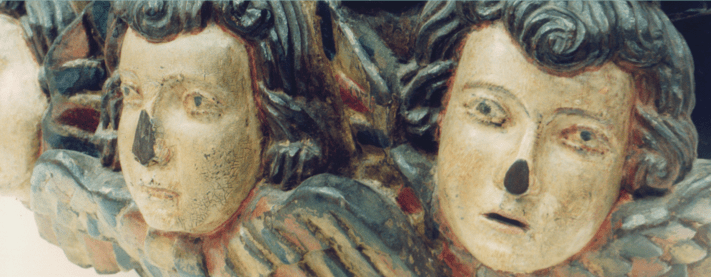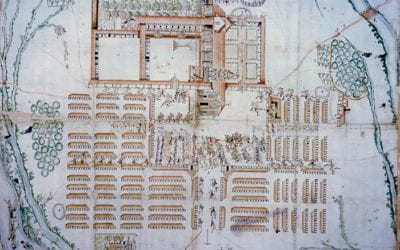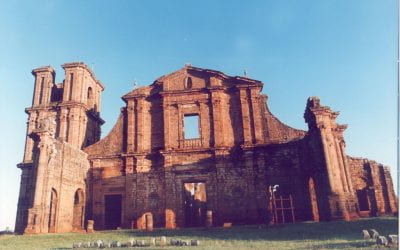Guaranis and Jesuits
Bordering the Spanish and the Portuguese Empires
The territory we currently identify as “Guarani” is presently divided between Paraguay, Argentina, Brazil and Uruguay. Although this partition of a community across national boundaries is a historical phenomenon more common than most assume, there is something particularly telling in this case. The location of the Guaranis near what would become a border between the rival empires of Spain and Portugal and then the various competing Latin American states was not accidental. Instead, it was directly related to who they were, how they came to be, and what were their relations with the powers that sought to dominate their territories from as early as the 16th century.
The first Spaniards who arrived to the region in the 1530s registered the existence of various native groups with distinct denominations such as the Chandules, Carios, Tobatines, Guarambarenses, and Itatines (to mention just a few examples). According to their narratives, the members of these groups lived in an extended territory between the rivers Paraguay, Paraná and Uruguay. Spanish reports admitted that members of these groups were distinguished from one another, but nevertheless suggested that they shared sociocultural traits and a language. Subjected to encomienda (an institution that in theory sanctioned their work for Spaniards in exchange for conversion and military protection) the Guarani became allies first, vassals of Spain second.
It was during this period—the late 16th century—that Spanish documentation began to categorize the members of these diverse groups as “Guarani.” It was also during this period that, through their interaction with Europeans, the members of these groups enhanced their relations with one another, gradually forming a single community and a single language, now identified as “colonial” or “creole” Guarani. Pervasive processes of mixing and cultural change also lead to the diffusion of some of these shared sociocultural traits and language to other individuals inhabiting the area, including descendants of Spaniards and mestizos.
The emergence of “the Guarani” as a distinct human group was thus tightly connected to colonialism. It was further enhanced by the activities of the Jesuit order, whose members began in the 1600s congregating the natives of the region into missions. By the end of the 17th century, there were some thirty such missions, with a total population of at least 100,000 natives. By the early 18th century, the geographical extension of this Jesuit enterprise was some 150,000 square miles (about the size of California). Nonetheless, while some historians portrayed the Guarani as passive receptors of European-imposed processes of change and ethnogenesis, a new historiography suggests that the Guarani were active participants in the developments that led to their formation, evolution, categorization and change. This new historiography further argues that their location in a contested area between rival powers and states greatly influenced the way these mutations happened because, by inhabiting a region that was to become a frontier, the Guarani had a greater freedom to negotiate who they were and who they would become.
The best-known episode in this longer story of how territorial conflicts between empires and states allowed natives a greater independence and a greater agency were the events that followed the signing of the Treaty of Madrid in 1750. In that treaty, which determined how Spain and Portugal would divide the South American continent between them, the Spanish king promised to evacuate all the settlements that were founded on the territory recognized as Portuguese. Among other things, this promise implied the obligation to evacuate seven Jesuit missions with some 30,000 Guaranis. The treaty made special arrangements for this evacuation, specifying that the missionaries would abandon the missions with their residents (the Guaranis), who would thereafter be resettled elsewhere within the territories recognized as Spanish. While residents and Jesuits could take with them all moveable goods, the houses, buildings, churches and lands would remain intact and would be transferred to Portugal.
Unsurprisingly, news of this agreement stirred an uproar. Discussions regarding its legality and wisdom took place both in the Spanish court and the Americas. The Jesuits sent missives to the Spanish king, first asking him not to sign the treaty and then criticizing him for ignoring their plea. Natives residing in the missions also protested against the order of evacuation. In a famous letter dated 1753 and written in Guaraní, Nicolás Ñenguirú, leader of one of the Guaraní communities, asked the governor of Buenos Aires if the news was accurate. He suggested that outrageous as they were, the instructions must be the result of a Portuguese plot, not the genuine mandate of the Spanish king. After all, Spanish monarchs knew better. They had always thanked the Guaraní for their loyalty and service, and always promised them not only rewards but also protection. Under these circumstances, how could a Spanish king order an evacuation, which surely would cause the Guarani great harm, expelling them from their lands in order to give them to the Portuguese? How could the king mandate that they give away all that they had achieved by their labor? If such were the case, what was the point of bringing them to the mission in the first place? In his letter, Ñenguirú described the growing rage in his community and confessed that he could no longer control his men, who refused to listen to his explanations. But he himself was not clear of what he could say as he too did not understand how this could have happened.
Many other Guarani leaders sent similar missives. They also corresponded among themselves and with the Jesuits, trying from as early as 1753 to coordinate a common response. This restiveness was probably the reason why, eventually, most Guaranis refused to abandon their villages. The Spanish and the Portuguese responded to this disobedience with violence, unleashing a war that took place between 1754 and 1756 and led to an enormous death toll and to the destruction and abandonment of most missions. Paradoxically, the difficulties in implementing the treaty of Madrid led to its annulment in 1761, leaving the territory of the Jesuit missions—now in ruin—under Spain.
While many accused the Jesuits of instigating the resistance and indeed believed that they might have written or at least co-authored many of the letters attributed to natives, it is currently agreed that by the mid-18th century the Guaranis had sufficient knowledge and familiarity with things Spanish to write such letters as well as to initiate, organize and carry out resistance. Clearly, by that time, some Guaranis were not only able to read and write, but they also understood that letters were a means of communication as well as a channel to express grievances. Among native elites, there was also an acute awareness of what was at stake and which arguments could carry the day. There was sufficient native political articulation, with substantial collaboration among indigenous people living in different villages. For present-day historians, therefore, rather than attributed to Jesuit long-hand, these events testified to the existence of a Guarani body-politic with a potential for self-government.
How the different Guarani groups acquired this identity, knowledge and grassroots organization is hard to ascertain. Certainly, the various groups shared many traits and communal existence before the arrival of Europeans. However, the presence of Spaniards contributed to the emergence of a Pan-Guarani identity that stressed what was common (rather than what was different). The use of Guarani as the lingua franca of this particular colonial world also led to homogenization, as did the arrival of missionaries and the subjection of many (although not all) Guaranis to a common religious teaching and a common daily discipline. Because of these processes, Guarani, which originally consisted of a family of spoken languages became a single, written language. The congregation in missions also allowed the settling of different Guarani groups in particular places, and the relationship between the diverse missions permitted the intensification of relations between these groups. But it is also possible that what allowed the Guaranis to be identified as a group and be distinguished from other natives was precisely their location on a territory contested among empires and crowns.
Returning to the 1750 episode, the Guaranis who refused to evacuate the missions explained that they would rather fight than leave their lands to the Portuguese, whom they considered their enemies. Identifying themselves as vassals of Spain, the willingness of the Guarani to come to the missions in the first place was probably tied to Spain’s rivalry with Portugal, as well as with other native groups allied with them. In the missions, the Guaranis were protected from serving Spaniards (in encomienda or elsewhere) and received tools and instruction; they were also protected from captivity by slave traders from São Paulo, who in the early 17th century expanded their activities to the area the Guaranis inhabited. According to statistics mainly based on Jesuit reports, between 1628 and 1631, for example, some 60,000 mission Indians were captured by these slaving expeditions, which sometime were manned by as many as 2,400 individuals, both native and European. To resist these expeditions, from the 1630s Jesuits armed and militarily trained the Guaranis. The only army present on the border during the 17th and the early 18th century, Guarani soldiers were constantly sent to defend Spanish interests. This military involvement—mainly against the Portuguese—confirmed (to Europeans) the bellicose nature of the Guarani, but it also stressed their proximity to the border and their rivalry with the Portuguese.
Despite claims that Guarani resistance to the evacuation of the missions in the 1750s confirmed the suspicion that they were disloyal to Spain, it is clear that the natives living in the missions initially identified their own interests with the persistence of Spanish presence. Not only did they resist leaving houses, crops and land, they also feared that if they fell under Portuguese control they might be enslaved and their communities dismantled. Yet, if in the 17th century the Guarani chose Spain, later they changed their minds. There are plenty of indications, for example, that during the war following the Treaty of Madrid (1754-1756) perhaps as many as 3,000 Guaranis who were disillusioned with Spain had transferred their loyalty to Portugal. They did so in groups and gradually, as they witnessed the unfolding of the drama that forced them to abandon their missions without clear destination and without royal assistance.
Location on the border thus determined the way the Guarani would be defined and how they would act. Yet, contrary to common narratives, the border did not exist before the Guarani were created as a group, nor were prior-established Jesuit missions caught up in the struggle for hegemony between Spain and Portugal. On the contrary, both the Guaranis and the missions were the instruments by which Spain sought to exercise and increment its control. The reason the border between Spain and Portugal ended up passing back and forth in that region, therefore, was precisely the continuous struggle over the allegiance of the Guarani. It is clear, for example, that during the 18th century Jesuits expanded their territories (and, as a byproduct, those of Spain) by transferring some Guaranis to the eastern bank of the River Uruguay. This politics of population transfer to a territory whose submission to Europeans was not yet determined—it was unclear whether it would fall under one European power or the other—implicated the Guaranis in European debates. The Guaranis, furthermore, were not only to occupy the territory but also to patrol it against Portuguese pretensions. But if initially the Guaranis expressed strong anti-Portuguese sentiments, by the 1750s many of them felt betrayed by Spain (and Jesuits). Aware of these complexities, from the 1750s, the Portuguese attempted to attract these dissatisfied Indians by offering them better treatment, abundant gifts and certain privileges. The Portuguese also intensified commerce with these groups, promising their members that they would be allowed to remain in their villages. Here again, a population transfer had the potential to affect where the border would pass: in 1801 the seven missions became Portuguese not by virtue of a military conquest or an international treaty, but because of the initiative and consent of their Guaraní inhabitants, who now wanted to become Portuguese.
Spring 2015, Volume XIV, Number 3
Tamar Herzog is Monroe Gutman Professor of Latin American Affairs and Professor of Spanish and Portuguese History at Harvard University. She is also an affiliated faculty member at Harvard Law School and a Radcliffe Alumnae Professor. Her most recent book, Frontiers of Possession: Spain and Portugal in Europe and the Americas (Harvard University Press, 2014), studies how boundaries were formed on the ground by neighbors and how the right to land was discussed, negotiated, obtained or denied.
Related Articles
Jesuit Reflections on their Overseas Missions
When you think of Jesuits in their missions around the world, you—the casual reader—might not think of Plato or ancient Greek authors. Yet two of these…
Paraguay: Un país en una lengua misteriosa y singular
English + Español
If you arrived in a country where almost 90% of the inhabitants speak Guarani, an official and national language along with Spanish but do not identify themselves as “Indian” or aboriginal…
Territory Guarani: Editor’s Letter
DRCLAS receptions are bustling affairs, sparkling with ample liquor, Latin American tidbits and compelling conversations. It was at one of these receptions that Jorge Silvetti and Graciela Silvestri first approached me casually regarding an issue about the Guarani…





